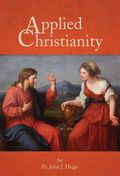Categories
Information
All Products
Father John J. Hugo - PB - 330 pages
This is the second of three books written by Fr. John J. Hugo concerning the great 20th century spiritual retreat master, Fr. Onesimus Lacouture S.J. and his work. The first published by Loreto was The Gospel of Peace, and the third to be re-issued is entitled A Sign of Contradiction.
Fr. Lacouture was a Jesuit who had the great gift of being a masterful director of souls. Being a Jesuit formed in the old mold of true Ignatian spirituality and deeply affected by the so-called “French School” of Berulle, St. John Eudes, and St. Louis Marie de Montfort, his retreats, given to over 6000 American and Canadian priests, produced extraordinary results. His most well known disciple and good friend, Fr. Hugo, has produced for posterity, the Notes from those Ignatian retreats as given by Fr. Lacouture and subsequently by himself and many other priests.
The Notes are entitled Applied Christianity and few spiritual writers of the 20th century have put in such clear and lucid language a precise (and practical) explanation of the true nature of a Christian life. This work will be compared to the works of such great writers on the spiritual life as St. John Eudes, Abbot Dom Marmion, Dom Chautard, St. Ignatius of Loyola and others.
Part One: Natural and Supernatural
I. The Two Principles of Activity
II. The Two Principles of Activity: Application
III. The Harmony Between the Natural and the Supernatural
IV. The Conflict Between the Natural and the Supernatural
V. The Pagan Mentality
VI. The Law of the Flesh
VII. Jesus Speaks of the Supernatural Life
VIII. The Christian Mentality
IX. Christian Perfection
Part Two: The Supernatural World
I. The Glory of God: Doctrine
II. The Glory of God: Application
III. The Doctrine of the Samples
IV. The Doctrine of the Samples Applied
V. The Supreme Dominion of God: Doctrine
VI. The Supreme Dominion of God: Application
VII. The Folly of the Cross: Doctrine
VIII. The Folly of the Cross: Application
IX. Summary and Objections
Part Three: The Samples
I. The Love of God
II. The Contempt of the World: Doctrine
III. The Contempt of the World: Application
IV. Forbidden Samples
V. Sin
VI. The Remedies for Sin
VII. Hell
Part Four: The Supreme Dominion of God
I. The Supreme Dominion: God’s Intention
II. The Supreme Dominion in Persons: Blind Instruments
III. The Supreme Dominion in Superiors: Obedience
IV. Source of God’s Supreme Dominion: The Divine Will
V. The Supreme Dominion of God in us: The Human Will
Part Five: The Folly of the Cross
I. Almsgiving: The Sowing of External Goods
II. Mortification: The Sowing of Bodily Goods
III. Afflictions: The Sowing of Interior Goods
IV. Death: The Sowing of Everything
Appendix
I. Nature and Grace
II. Are Natural Actions Meritorious?
III. Christian Moderation
Father John J. Hugo - 330 pages - Ebook as EPUB, Kindle, or PDF
This is the second of three books written by Fr. John J. Hugo concerning the great 20th century spiritual retreat master, Fr. Onesimus Lacouture S.J. and his work. The first published by Loreto was The Gospel of Peace, and the third to be re-issued is entitled A Sign of Contradiction.
Fr. Lacouture was a Jesuit who had the great gift of being a masterful director of souls. Being a Jesuit formed in the old mold of true Ignatian spirituality and deeply affected by the so-called “French School” of Berulle, St. John Eudes, and St. Louis Marie de Montfort, his retreats, given to over 6000 American and Canadian priests, produced extraordinary results. His most well known disciple and good friend, Fr. Hugo, has produced for posterity, the Notes from those Ignatian retreats as given by Fr. Lacouture and subsequently by himself and many other priests.
The Notes are entitled Applied Christianity and few spiritual writers of the 20th century have put in such clear and lucid language a precise (and practical) explanation of the true nature of a Christian life. This work will be compared to the works of such great writers on the spiritual life as St. John Eudes, Abbot Dom Marmion, Dom Chautard, St. Ignatius of Loyola and others.
Part One: Natural and Supernatural
I. The Two Principles of Activity
II. The Two Principles of Activity: Application
III. The Harmony Between the Natural and the Supernatural
IV. The Conflict Between the Natural and the Supernatural
V. The Pagan Mentality
VI. The Law of the Flesh
VII. Jesus Speaks of the Supernatural Life
VIII. The Christian Mentality
IX. Christian Perfection
Part Two: The Supernatural World
I. The Glory of God: Doctrine
II. The Glory of God: Application
III. The Doctrine of the Samples
IV. The Doctrine of the Samples Applied
V. The Supreme Dominion of God: Doctrine
VI. The Supreme Dominion of God: Application
VII. The Folly of the Cross: Doctrine
VIII. The Folly of the Cross: Application
IX. Summary and Objections
Part Three: The Samples
I. The Love of God
II. The Contempt of the World: Doctrine
III. The Contempt of the World: Application
IV. Forbidden Samples
V. Sin
VI. The Remedies for Sin
VII. Hell
Part Four: The Supreme Dominion of God
I. The Supreme Dominion: God’s Intention
II. The Supreme Dominion in Persons: Blind Instruments
III. The Supreme Dominion in Superiors: Obedience
IV. Source of God’s Supreme Dominion: The Divine Will
V. The Supreme Dominion of God in us: The Human Will
Part Five: The Folly of the Cross
I. Almsgiving: The Sowing of External Goods
II. Mortification: The Sowing of Bodily Goods
III. Afflictions: The Sowing of Interior Goods
IV. Death: The Sowing of Everything
Appendix
I. Nature and Grace
II. Are Natural Actions Meritorious?
III. Christian Moderation




